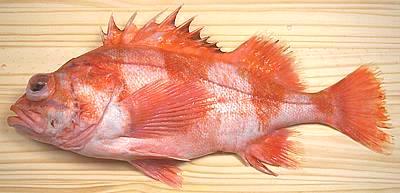 [Red Bandit, Sebastes babcocki]
[Red Bandit, Sebastes babcocki]
This Pacific rockfish is found from the northern tip of Japan all the way around and down to San Diego, California but is most populous along the south coast and islands of Alaska. It can grow to 25 inches and almost 10 pounds, but the photo specimen was 17 inches and 3 pounds. It is sold in Asian markets in Southern California, often labeled "Red Bandit". Colors may be lighter than on the photo specimen. A slow growing fish of moderate population, it's mainly an incidental catch and unlikely to be found in markets far from the Pacific Coast. Photo © cg1
More on Rockfish.
Redbanded Rockfish is an excellent eating fish (when fresh) with white, moderately flavored flesh that is tender but holds together well with any cooking method. It separates into large flakes and it's easy to eliminate all bones.
Cleaning: No particular problems cleaning this fish. The scales are fairly large and easy to scrape off without a lot of flying around. There are a few that stick hard on the lateral line and would need to be pulled off with long nose pliers only if you intend to leave the skin on.
Use your filleting knife, sharp edge out, to cut from the vent to the fins, then your kitchen shears to cut from the fins up to the chin. You will have to use your kitchen shears to cut the esophagus and the ends of the gill arches, and a few other spots, mainly because this is a large fish.
Fillet: Redbanded Rockfish is rather easy to fillet, with easy to follow fin rays and bones.
Skin: The skin shrinks severely when heated (as does the membrane lining the body cavity) but it's a very easy fish to skin using the long knife and cutting board technique. While skin must be removed from fillets so it will not destroy them, you can bake a moderate size fish whole, but do make a few diagonal slashes half way through the flesh so the skin won't tear it up and make it look really ugly. Those cuts will open up wide, but that just lets the sauce in.
Yield: A 3 pound ounce fish yielded fillets weighing 1 pound 3 ounces of skin-off fillet (39%), which is not bad for a large head fish like this. A smaller fish will yield a bit less, a larger fish a bit more. There's a couple more ounces of flesh with the head and fins but you'd need to do a short simmer to recover it.
sf_rockbz 061101 - www.clovegarden.com